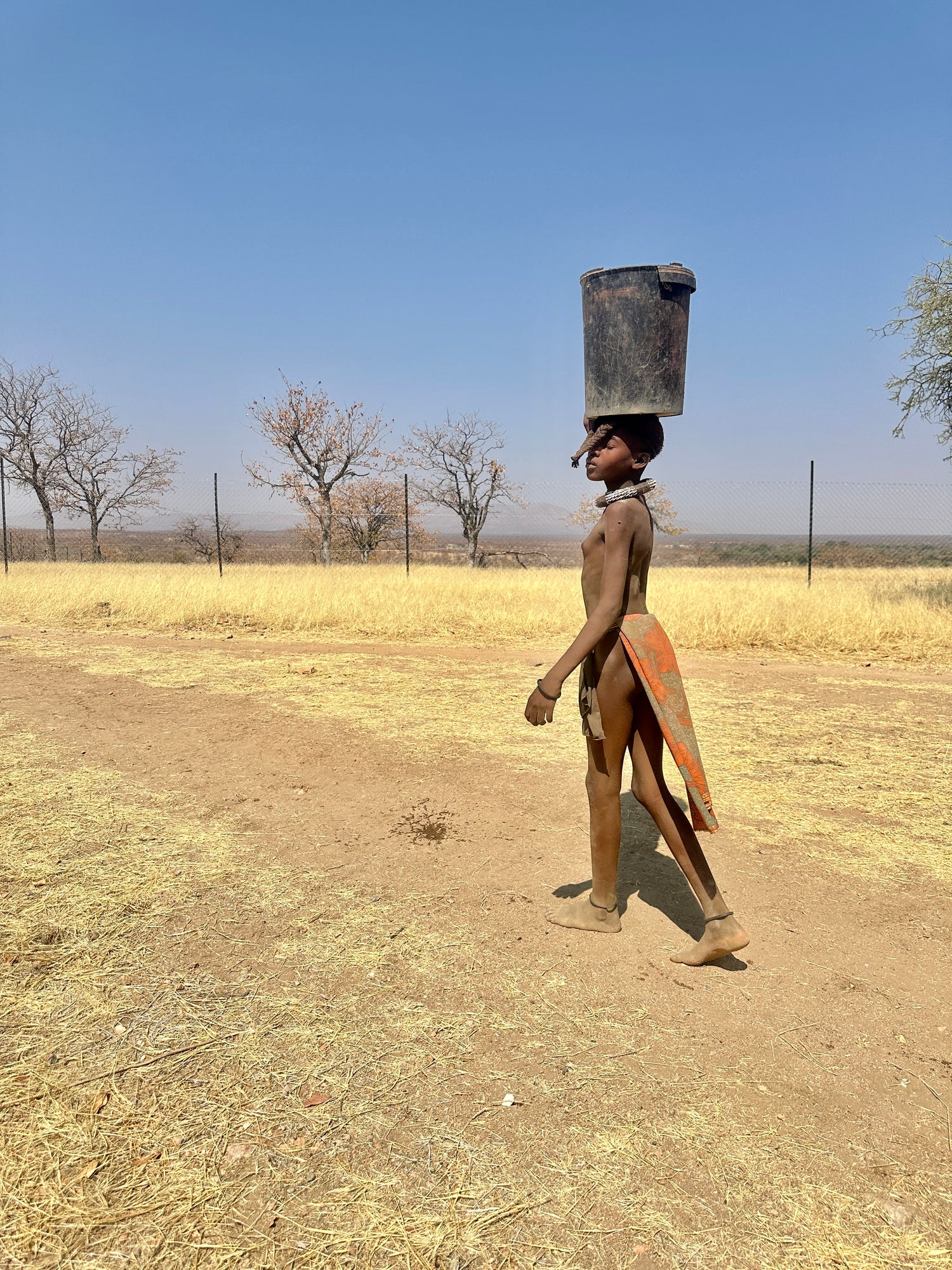
Food Forests in Namibia
Sadhana Forest’s work in Namibia focuses on reforestation, water conservation, and community empowerment in the Kunene Region.
Project Impact
Sadhana Forest’s work in Namibia focuses on reforestation, water conservation, and community empowerment in the Kunene Region. Since 2023, Sadhana Forest has been working closely with the Oruseu, Okapara, and neighboring villages, where the project has been planting indigenous, drought-resistant food-producing trees. The project aims to address severe food insecurity and environmental degradation by improving access to nutritious foods and replenishing the local ecosystem.
By 2024, Sadhana Forest Namibia successfully completed key infrastructure projects, including the installation of a solar system and the drilling of a bore-well to ensure reliable access to water. The site also features water towers with 10,000-liter tanks, providing fresh water to both the local community and the project site. This water is used to irrigate the newly planted trees and for household needs in the surrounding villages. The availability of water has been life-changing for local residents, who now have access to drinking water taps and can fill up bottles and jerrycans for household use.
Tree Planting: In early 2024, the first trees were planted at the Oruseu and Okapara villages. This was a memorable event for the local Himba community, as it was the first time they had ever planted trees. The project has already sparked excitement and a sense of pride in the local population, who can see the positive changes the trees will bring to their environment.
Community Engagement and Training: Sadhana Forest has been working to build strong relationships with the local Himba people, engaging them in the project through daily tree-planting activities. A team of motivated and reliable members from the local community has been recruited to help with planting and fencing. Additionally, training in sustainable land management and agroforestry has been provided, empowering the community to take ownership of the reforestation efforts and ensuring the long-term success of the project.
Water Conservation: To complement the reforestation efforts, water conservation techniques such as bunds and swales are being implemented. The borewell provides a reliable water source, but capturing rainwater and maximizing its use for the land remains a critical focus of the project.
Social Impact: Beyond environmental restoration, the project is addressing severe malnutrition by planting indigenous food trees like Moringa ovalifolia, which can provide essential nutrients that are currently lacking in the community’s diet. The availability of water and nutritious food will have long-term benefits for the health and well-being of the local population.
Project location
Sadhana Forest Namibia, Kunene Region, Namibia
Why plant in Namibia

Project Details

What are food forests?
The idea of forest gardens (food forests) was first articulated by Robert Hart in his book ‘Forest Gardening’ and subsequently became one of the keystone concepts in Permaculture. A Permaculture forest garden mimics the architecture and beneficial relationships of a natural forest. Food forests are not ‘natural’, but are designed and managed ecosystems that are very rich in biodiversity and productivity, and are based on a philosophy of co-operation with nature.
A food forest is typically composed of seven layers: the uppermost layer is the canopy layer that is composed of tall trees, mostly large fruit and nut trees. Between the tall canopy layer trees there is a layer of low growing fruit trees, and nestled between all these small trees are the shrubs which are well represented by currants and berries. Filling the remaining space is the herbaceous layer: these are the culinary and medicinal herbs, companion plants, bee-forage plants, and poultry forage plants. Any remaining space is occupied by ground cover plants, which form a living mulch that protects the soil, reduces water loss to evaporation, and prevents weeds from growing. While that might seem like a lot of plants in one space, there is still one more to fill: the upright vertical space. This is filled by climbers and vines, which can be run up fences, trees, or any other vertical support. This category includes grapes, climbing beans, many berries, passion fruit, kiwi fruit, climbing peas, and many other species that love to climb.
Food forests provide many benefits like high productivity per acre; natural mulch, compost, & fertilizer; natural pest control by using natural predators, and a resilience that can only come through biodiversity.
Learn more about Food forests and permaculture here

Impacts of deforestation on Himba communities:
Deforestation has significant impacts on the Himba community in Namibia, particularly in terms of food insecurity and environmental degradation. The Himba people, who are traditionally semi-nomadic pastoralists, depend heavily on the natural environment for their livelihood, including grazing land, wild plants, and water sources. However, due to the increasing deforestation in the region, the community faces several challenges:
Impacts of Deforestation:
- Food Insecurity and Malnutrition:
As forests are cleared, the Himba lose access to wild food sources such as fruits, nuts, and plants that traditionally supplement their diet. Additionally, the reduction in grazing land due to forest loss impacts their livestock, leading to diminished availability of milk and other food products. This has contributed to a rise in malnutrition, especially among vulnerable populations such as children. - Water Scarcity:
Forests play a crucial role in regulating water cycles and preventing soil erosion. The loss of forest cover exacerbates water scarcity, as the land becomes less capable of retaining water. This results in droughts and depleted water sources, further threatening both human and livestock survival in the region. - Land Degradation and Soil Erosion:
Deforestation leads to soil degradation and erosion, making it difficult for the Himba to cultivate land or maintain sustainable grazing practices. With less vegetation to anchor the soil, the land becomes barren, further worsening the region’s ability to support agriculture and livestock. - Biodiversity Loss:
The loss of forest cover also results in a decline in biodiversity, affecting both flora and fauna that the Himba rely on for food, medicine, and cultural practices. As natural habitats are destroyed, wildlife populations decline, and many species face the risk of extinction. - Cultural Impact:
The Himba have a deep cultural connection to the land and its natural resources. The destruction of forests disrupts traditional practices and rituals tied to the environment, eroding their cultural identity over time.

How is Sadhana Forest creating food forests in Himba tribal communities?
Sadhana Forest is creating food forests in Himba tribal communities by implementing a sustainable model of reforestation that focuses on planting indigenous, drought-resistant, food-bearing trees. This approach not only helps restore degraded lands but also improves food security for the Himba people, who face significant challenges due to deforestation and desertification. Here's how they are doing it:
- Planting Indigenous, Food-Producing Trees:
Sadhana Forest selects native species that are resilient to the arid conditions of the region, such as Moringa ovalifolia. These trees are rich in nutrients and can thrive with minimal water. As these trees mature, they provide fruits, nuts, and other edible parts that enhance the nutritional intake of the Himba community, addressing malnutrition and providing a reliable food source. - Water Conservation Techniques:
Since the Himba communities live in a region with scarce water resources, Sadhana Forest incorporates water conservation methods such as on-contour swales, bunds, crescent moon trenches, and gabions. These techniques help to capture rainwater, improve soil moisture, and ensure the survival of the newly planted trees. This creates a more sustainable environment for food production, even in times of drought. - Sustainable Land Management and Training:
Sadhana Forest engages the Himba community through training programs that focus on agroforestry and sustainable land management. By empowering the locals with the skills needed to plant and care for these food forests, the community becomes self-sufficient in maintaining and expanding these reforestation efforts, ensuring long-term food security. - Soil Restoration and Ecosystem Recovery:
The introduction of food forests helps to restore soil health by reducing erosion and improving the land’s fertility. Over time, this leads to the regeneration of the ecosystem, allowing other forms of vegetation to grow, further supporting both the environment and the food needs of the Himba people.
Through these efforts, Sadhana Forest is creating a sustainable, plant-based food system that not only addresses food insecurity but also strengthens the community’s resilience to climate change and environmental degradation.
UN Sustainable Development Goals contributed to
The United Nations Sustainable Development Goals (SDGs) are a set of 17 interconnected global objectives aimed at addressing pressing social, economic, and environmental challenges by 2030. They serve as a blueprint for collective action, guiding governments, businesses, and communities worldwide towards a more sustainable and equitable future.
This project contributes to the following goals
Verification
For each tree planted with Sadhana Forest, the patron will receive evidence of the planting in the form of a photograph of the planted tree, species detail and the exact date and co-ordinate of planting. Patrons are welcome to visit their trees at any time.




